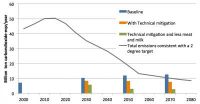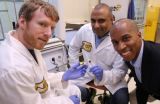(Press-News.org) Greenhouse gas emissions from food production may threaten the UN climate target of limiting global warming to 2 degrees Celsius, according to research at Chalmers University of Technology, Sweden.
On Monday 31 March the Intergovernmental Panel on Climate Change (IPCC) presents their report on the impacts of climate change.
Carbon dioxide emissions from the energy and transportation sectors currently account for the largest share of climate pollution. However, a study from Chalmers now shows that eliminating these emissions would not guarantee staying below the UN limit. Emissions from agriculture threaten to keep increasing as global meat and dairy consumption increases. If agricultural emissions are not addressed, nitrous oxide from fields and methane from livestock may double by 2070. This alone would make meeting the climate target essentially impossible.
"We have shown that reducing meat and dairy consumption is key to bringing agricultural climate pollution down to safe levels," says Fredrik Hedenus, one of the study authors. "Broad dietary change can take a long time. We should already be thinking about how we can make our food more climate friendly."
By 2070, there will be many more of us on this planet. Diets high in meat, milk, cheese, and other food associated with high emissions are expected to become more common. Because agricultural emissions are difficult and expensive to reduce via changes in production methods or technology, these growing numbers of people, eating more meat and dairy, entail increasing amounts of climate pollution from the food sector.
"These emissions can be reduced with efficiency gains in meat and dairy production, as well as with the aid of new technology," says co-author Stefan Wirsenius. "But the potential reductions from these measures are fairly limited and will probably not suffice to keep us within the climate limit, if meat and dairy consumption continue to grow."
Beef and lamb account for the largest agricultural emissions, relative to the energy they provide. By 2050, estimates indicate that beef and lamb will account for half of all agricultural greenhouse gas emissions, while only contributing 3 percent of human calorie intake. Cheese and other dairy products will account for about one quarter of total agricultural climate pollution.
INFORMATION: END
Meeting climate targets may require reducing meat and dairy consumption
2014-03-30
ELSE PRESS RELEASES FROM THIS DATE:
Genetic markers may predict when people with heart disease are likely to have a heart attack
2014-03-30
Researchers at the Intermountain Medical Center Heart Institute in Salt Lake City have identified a biological process that may help physicians predict when someone with heart disease is likely to have a heart attack in the near future.
A new study by the team has identified plasma levels of two markers – microRNA 122 and 126 – that appear to decline a few days before a person suffers a heart attack. Results of the study could help the 715,000 Americans who suffer from heart attacks each year.
"It's always been a mystery trying to identify people with heart disease ...
Researchers uncover secrets of a mollusk's unique bioceramic armor
2014-03-30
CAMBRIDGE, Mass-- The shells of a sea creature, the mollusk Placuna placenta, are not only exceptionally tough, but also clear enough to read through. Now, researchers at MIT have analyzed these shells to determine exactly why they are so resistant to penetration and damage — even though they are 99 percent calcite, a weak, brittle mineral.
The shells' unique properties emerge from a specialized nanostructure that allows optical clarity, as well as efficient energy dissipation and the ability to localize deformation, the researchers found. The results are published this ...
New study finds strong link between obesity and 'carb breakdown' gene
2014-03-30
Researchers at King's College London and Imperial College London have discovered that people with fewer copies of a gene coding for a carb-digesting enzyme may be at higher risk of obesity. The findings, published in Nature Genetics, suggest that dietary advice may need to be more tailored to an individual's digestive system, based on whether they have the genetic predisposition and necessary enzymes to digest different foods.
Salivary amylase plays a significant role in breaking down carbohydrates in the mouth at the start of the digestion process. The new study suggests ...
Earth's dynamic interior
2014-03-30
VIDEO:
This video shows a numerical simulation of Earth's deep mantle. The top panel is temperature and the bottom panel is composition which includes three components: the more-primitive reservoir at the...
Click here for more information.
TEMPE, Ariz. – Seeking to better understand the composition of the lowermost part of Earth's mantle, located nearly 2,900 kilometers (1,800 miles) below the surface, a team of Arizona State University researchers has developed new simulations ...
Heat-conducting polymer cools hot electronic devices at 200 degrees C
2014-03-30
Polymer materials are usually thermal insulators. But by harnessing an electropolymerization process to produce aligned arrays of polymer nanofibers, researchers have developed a thermal interface material able to conduct heat 20 times better than the original polymer. The modified material can reliably operate at temperatures of up to 200 degrees Celsius.
The new thermal interface material could be used to draw heat away from electronic devices in servers, automobiles, high-brightness LEDs and certain mobile devices. The material is fabricated on heat sinks and heat ...
Scientists pinpoint why we miss subtle visual changes, and why it keeps us sane
2014-03-30
Ever notice how Harry Potter's T-shirt abruptly changes from a crewneck to a henley shirt in "The Order of the Phoenix," or how in "Pretty Woman," Julia Roberts' croissant inexplicably morphs into a pancake? Don't worry if you missed those continuity bloopers. Vision scientists at the University of California, Berkeley, and the Massachusetts Institute of Technology have discovered an upside to the brain mechanism that can blind us to subtle changes in movies and in the real world.
They've discovered a "continuity field" in which the brain visually merges similar objects ...
A new approach to Huntington's disease?
2014-03-30
Tweaking a specific cell type's ability to absorb potassium in the brain improved walking and prolonged survival in a mouse model of Huntington's disease, reports a UCLA study published March 30 in the online edition of Nature Neuroscience. The discovery could point to new drug targets for treating the devastating disease, which strikes one in every 20,000 Americans.
Huntington's disease is passed from parent to child through a mutation in the huntingtin gene. By killing brain cells called neurons, the progressive disorder gradually deprives patients of their ability ...
Erasing a genetic mutation
2014-03-30
CAMBRIDGE, MA -- Using a new gene-editing system based on bacterial proteins, MIT researchers have cured mice of a rare liver disorder caused by a single genetic mutation.
The findings, described in the March 30 issue of Nature Biotechnology, offer the first evidence that this gene-editing technique, known as CRISPR, can reverse disease symptoms in living animals. CRISPR, which offers an easy way to snip out mutated DNA and replace it with the correct sequence, holds potential for treating many genetic disorders, according to the research team.
"What's exciting about ...
Effect of important air pollutants may be absent from key precipitation observations
2014-03-30
Pioneering new research from the University of Exeter could have a major impact on climate and environmental science by drastically transforming the perceived reliability of key observations of precipitation, which includes rain, sleet and snow.
The ground breaking study examines the effect that increased aerosol concentrations in the atmosphere, emitted as a result of burning fossil fuels, had on regional temperature and precipitation levels.
Scientists from Exeter's Mathematics department compared observed regional temperature and precipitation changes throughout ...
Genetic mutations warn of skin cancer risk
2014-03-30
Researchers have discovered that mutations in a specific gene are responsible for a hereditary form of melanoma.
Every year in the UK, almost 12,000 people are diagnosed with melanoma, a form of skin cancer. About 1 in 20 people with melanoma have a strong family history of the disease. In these patients, pinpointing the genetic mutations that drive disease development allows dermatologists to identify people who should be part of melanoma surveillance programmes.
The team found that people with specific mutations in the POT1 gene were extremely likely to develop melanoma. ...


